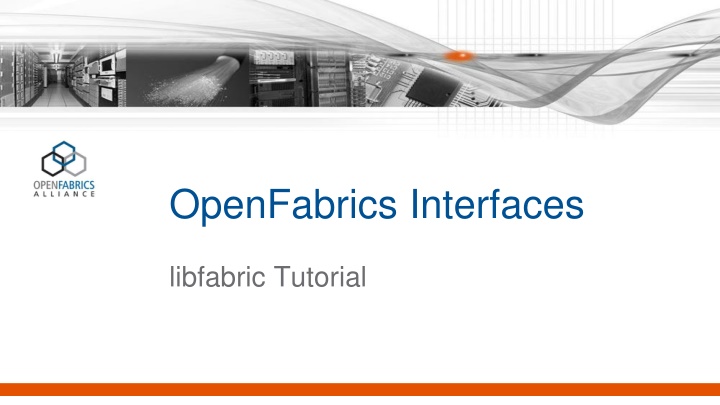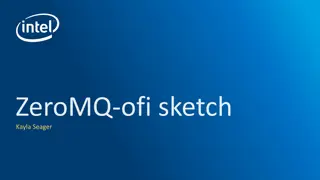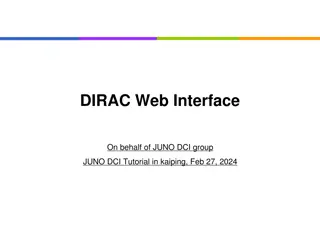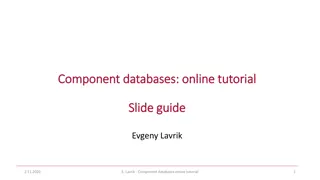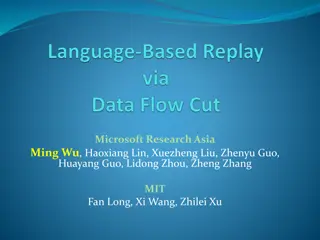libfabric: A Comprehensive Tutorial on High-Level and Low-Level Interface Design
This tutorial delves into the intricate details of libfabric, covering high-level architecture, low-level interface design, simple ping-pong examples, advanced MPI and SHMEM usage. Explore design guidelines, control services, communication models, and discover how libfabric supports various systems, including Linux and OS X. Acknowledge the contributors who have made this tutorial possible.
Download Presentation

Please find below an Image/Link to download the presentation.
The content on the website is provided AS IS for your information and personal use only. It may not be sold, licensed, or shared on other websites without obtaining consent from the author.If you encounter any issues during the download, it is possible that the publisher has removed the file from their server.
You are allowed to download the files provided on this website for personal or commercial use, subject to the condition that they are used lawfully. All files are the property of their respective owners.
The content on the website is provided AS IS for your information and personal use only. It may not be sold, licensed, or shared on other websites without obtaining consent from the author.
E N D
Presentation Transcript
OpenFabrics Interfaces libfabric Tutorial
Overview High-level Architecture Low-level Interface Design Simple Ping-pong Example Advanced MPI Usage SHMEM Usage
Overview This tutorial covers libfabric as of the v1.1.1 release Future versions might look a little different, but the v1.1 interface should remain available for a long time Man pages, source, presentations all available at: http://ofiwg.github.io/libfabric/ https://github.com/ofiwg/libfabric Code on slides deliberately omits error checking for clarity
Developer Note libfabric supports a sockets provider Allows it to run on most Linux systems Includes virtual Linux environments Also runs on OS X brew install libfabric
Acknowlegements Contributors to this tutorial not present today: Bob Russell, University of New Hampshire Sayantan Sur, Intel Jeff Squyres, Cisco
High-Level Architecture Interfaces and Services Object-Model Communication Models Endpoints
Design Guidelines Application driven API Low-level fabric services abstraction Extensibility built into interface Optimal impedance match between applications and underlying hardware Minimize software overhead Maximize scalability Implementation agnostic
Control Services Discover information about types of fabric services available Identify most effective ways of utilizing a provider Request specific features Convey usage model to providers
Communication Services Setup communication between processes Support connection-oriented and connectionless communication Connection management targets ease of use Address vectors target high scalability
Completion Services Asynchronous completion support Event queues for detailed status Configurable level of data reported Separation between control versus data operations Low-impact counters for fast notification
Data Transfer Services Supports different communication paradigms: Message Queues - send/receive FIFOs Tag Matching - steered message transfers RMA - direct memory transfers Atomics - direct memory manipulation
High-Level Architecture Interfaces and Services Object-Model Communication Models Endpoints
Object-Model Passive endpoints Fabric Event queues Wait sets Completions queues Domain Address vector Completion counters Memory regions Active endpoints Poll sets
Fabric Object Represent a single physical or virtual network Shares network addresses May span multiple providers Future: topology information Passive endpoints Event queues Fabric Wait sets Completions queues Address vector Domain Memory regions Completion counters Active endpoints Poll sets
Domain Object Logical connection into a fabric Physical or virtual NIC Boundary for associating fabric resources Passive endpoints Event queues Fabric Wait sets Completions queues Address vector Domain Memory regions Completion counters Active endpoints Poll sets
Passive Endpoint Used by connection- oriented protocols Listens for connection requests Often map to software constructs Can span multiple domains Passive endpoints Event queues Fabric Wait sets Completions queues Address vector Domain Memory regions Completion counters Active endpoints Poll sets
Event Queue Report completion of asyn- chronous control operations Report error and other notifications Explicitly or implicitly subscribe for events Often mix of HW and SW support Usage designed for ease of use Passive endpoints Event queues Fabric Wait sets Completions queues Address vector Domain Memory regions Completion counters Active endpoints Poll sets
Wait Set Optimized method of waiting for events across multiple event queues, completion queues, and counters Abstraction of wait object(s) Enables platform specific, high-performance wait objects Uses single wait object when possible Passive endpoints Event queues Fabric Wait sets Completions queues Address vector Domain Memory regions Completion counters Active endpoints Poll sets
Active Endpoint Data transfer communication portal Identified by fabric address Often associated with a single NIC Hardware Tx/Rx command queues Support onload, offload, and partial offload implementations Passive endpoints Event queues Fabric Wait sets Completions queues Address vector Domain Memory regions Completion counters Active endpoints Poll sets
Active Endpoint Types FI_EP_DGRAM Unreliable datagram FI_EP_MSG Reliable, connected FI_EP_RDM Reliable Datagram Message Reliable, unconnected
Completion Queue Higher performance queues for data transfer completions Associated with a single domain Often mapped to hardware resources Optimized to report successful completions User-selectable completion format Detailed error completions reported out of band Passive endpoints Event queues Fabric Wait sets Completions queues Address vector Domain Memory regions Completion counters Active endpoints Poll sets
Remote CQ Data Application data written directly into remote completion queue InfiniBand immediate data Support for up to 8 bytes Minimum of 4 bytes, if supported
Counters Lightweight completion mechanism for data transfers Report only number of successful/error completions Passive endpoints Event queues Fabric Wait sets Completions queues Address vector Domain Memory regions Completion counters Active endpoints Poll sets
Poll Set Designed for providers that use the host processor to progress data transfers Allows provider to use application thread Allows driving progress across all objects assigned to a poll set Can optimize where progress occurs Passive endpoints Event queues Fabric Wait sets Completions queues Address vector Domain Memory regions Completion counters Active endpoints Poll sets
Memory Region Local memory buffers exposed to fabric services Permissions control access Focused on desired application usage, with support for existing hardware Registration of locally used buffers Passive endpoints Event queues Fabric Wait sets Completions queues Address vector Domain Memory regions Completion counters Active endpoints Poll sets
Memory Registration Modes FI_MR_BASIC MR attributes selected by provider Buffers identified by virtual address Application must exchange MR parameters FI_MR_SCALABLE MR attributes selected by application Buffers accessed starting at address 0 Eliminates need to exchange MR parameters
Address Vector Store peer addresses for connectionless endpoints Map higher level addresses to fabric specific addresses Designed for high scalability Enable minimal memory footprint Optimized address resolution Supports shared memory Passive endpoints Event queues Fabric Wait sets Completions queues Address vector Domain Memory regions Completion counters Active endpoints Poll sets
Address Vector Types FI_AV_MAP Peers identified using a 64-bit fi_addr_t Provider can encode fabric address directly Enables direct mapping to hardware commands FI_AV_TABLE Peers identified using an index Minimal application memory footprint (0!) May require lookup on each data transfer
High-Level Architecture Services Object-Model Communication Models Endpoints
High-Level Architecture Services Object-Model Communication Models Endpoints
Basic Endpoint Simple endpoint configuration Tx/Rx completions may go to the same or different CQs Tx/Rx command queues
Shared Contexts Endpoints may share underlying command queues CQs may be dedicated or shared Enables resource manager to select where resource sharing occurs
Scalable Endpoints Targets lockless, multi-threaded usage Each context may be associated with its own CQ Single addressable endpoint with multiple command queues
Low-Level Design Control Interface Capability and Mode Bits Attributes
Control Interface - getinfo Modeled after getaddrinfo / rdma_getaddrinfo Explicit versioning for forward compatibility int fi_getinfo(uint32_t version, const char *node, const char *service, uint64_t flags, struct fi_info *hints, struct fi_info **info); Hints used to filter output Returns list of fabric info structures
Control Interface - fi_info Primary structure used to query and configure interfaces struct fi_info { struct fi_info *next; uint64_t uint64_t mode; ... }; caps; caps and mode flags provide simple mechanism to request basic fabric services
Control Interface - fi_info Enables apps to be agnostic of fabric specific addressing (FI_FORMAT_UNSPEC) .. struct fi_info { ... uint32_t addr_format; size_t src_addrlen; size_t dest_addrlen; void *src_addr; void *dest_addr; ... }; But also supports apps wanting to request a specific source or destination address Apps indicate their address format for all APIs up front
Control Interface - fi_info Links to attributes related to the data transfer services that are being requested struct fi_info { ... fid_t handle; struct fi_tx_attr *tx_attr; struct fi_rx_attr *rx_attr; struct fi_ep_attr *ep_attr; struct fi_domain_attr *domain_attr; struct fi_fabric_attr *fabric_attr; }; Apps can use default values or request minimal attributes
Low-Level Design Control Interface Capability and Mode Bits Attributes
Capability Bits Basic set of features required by application Desired features and services requested by application Primary - application must request to enable Secondary - application may request Provider may enable if not requested Providers enable capabilities if requested, or if it will not impact performance or security
Capabilities Specify desired data transfer services (interfaces) to enable Overrides default capabilities; used to limit functionality FI_READ FI_WRITE FI_SEND FI_RECV FI_REMOTE_READ FI_REMOTE_WRITE FI_MSG FI_RMA FI_TAGGED FI_ATOMIC
Capabilities Receive oriented capabilities FI_SOURCE Source address returned with completion data Enabling may impact performance FI_DIRECTED_RECV Use source address of an incoming message to select receive buffer FI_MULTI_RECV Support for single buffer receiving multiple incoming messages Enables more efficient use of receive buffers FI_NAMED_RX_CTX Used with scalable endpoints Allows initiator to direct transfers to a desired receive context
Capabilities FI_RMA_EVENT Supports generating completion events when endpoint is the target of an RMA operation Enabling can avoid sending separate message after RMA completes FI_TRIGGER Supports triggered operations Triggered operations are specialized use cases of existing data transfer routines FI_FENCE Supports fencing operations to a given remote endpoint
Mode Bits Provider requests to the application Requirements placed on the application Application indicates which modes it supports Requests that an application implement a feature Application may see improved performance Cost of implementation by application is less than provider based implementation Often related to hardware limitations
Mode Bits FI_CONTEXT Application provides scratch space for providers as part of all data transfers Avoids providers needing to allocate internal structures to track requests Targets providers that have a significant software component FI_LOCAL_MR Provider requires that locally accessed data buffers be registered with the provider before being used Supports existing iWarp and InfiniBand hardware
